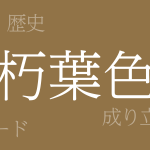Japan’s distinct seasonal colors enrich its traditional color palette. Among these, “Kareiro” (枯色 – かれいろ) captivates many with its subtlety and depth. This article explores the world of Kareiro, delving into its allure and significance in Japanese culture.
About Kareiro (枯色 – かれいろ)
Kareiro (枯色 – かれいろ) refers to a range of subdued, understated hues found in nature, much like the colors of withered plants and fallen leaves. These colors reflect the nuances of dried vegetation and evoke the fleeting nature of seasons, providing a tranquil and gentle palette that resonates deeply within Japanese aesthetics.
The History of Kareiro
Kareiro has been cherished throughout Japanese history. During the Heian period, the aristocracy embraced a culture of appreciating nature, popularizing the expression of seasonal ambiances through color. These hues were incorporated into clothing, architecture, and crafts, and have been passed down as traditional Japanese colors.
Color Code of Kareiro
In modern digital design and web production, accurate color codes are essential to replicate Kareiro. Here is an example:
- HEX: #E0C38C
- RGB: R:224 G:195 B:140
- CMYK: C:16 M:27 Y:49 K:0
Western Names for Kareiro
In the West, Kareiro is not directly translated; similar shades are referred to as “Taupe” or “Beige.” However, these names do not fully capture the subtle nuances and cultural background of Kareiro.
Summary on Kareiro
Kareiro is a traditional Japanese color that conveys the beauty and charm of nature. Its calm hues are incorporated into contemporary design and fashion, continuing to exude timeless appeal. In the digital age, knowing the color codes for Kareiro allows designers to utilize its profound shades to enhance their creative projects.

























